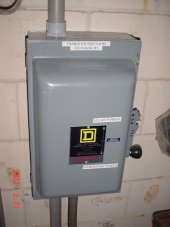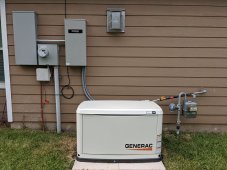This all depends on how you use the generator & what you do with it.
Battery Bank Charging is TYPICALLY Handled by either the Inverter/Charger or a dedicated Charger with a proper Charging Profile for the battery chemistry. DC from a Genset is not used for charging solar batteries. The most common method is to use the Inverter/Charger as the charger and to provide additional VAC input for Passthrough to home which keeps everything running. NOTE: Depending on Inverter/Charger this varies and some are not capable, so check your specs to know what your system can do.
LFP/LiFePo4 batteries typically can discharge at 1C Rate and take a max of 0.5C Charge Rate, so for a 24V/280AH Battery, that means it can discharge at a max of 280A for 1 hour or take 140A Charge for 2 hours MAX (not suggested). Most people will charge at 0.25C which is much gentler on the cells and keeps "runners" at bay.
SIZING the Generator is important.
Look at the Charger Device you have and at how many Amps it can charge at for your battery voltage and how much passthrough is used. Passthrough is the usual amount of power being used to run the home without heavy loads (like electric dryer/hot water tank, electric stove).
Example:
I have 24V Battery Bank, 1200AH in 6 packs. Inverter/Charger set to 80A Charge Rate to battery bank, this takes 120V/22-23A (it floats a little) + Passthrough power which the inverter feeds directly to my AC Side. This is roughly 2800W (120V X 23A=2760W) which is provided by the Genset L5:30 Plug (120V/30A) I am running with a Champion Power Equipment INVERTER GENERATOR 4650W Model which is very quiet, reliable, easy to maintain... I have had no issues with Champion Equipment and my Big 9200W has well over 1000 hours and purrs like a kitten, just have to change the oil and clean the filters per schedule. REF:
Champion 4500W and up Inverter Generators
Pure Sine Inverter Generators are not only considerably quieter they provide clean pure sine wave form which is best for your electronics and motors (fridge, AC etc). A regular Construction/Industrial use genset is MOD-SINE (much cheaper) which the Frequency will float from 57-63 Hz and is not consistent (you'll notice lights will flicker a bit, fridge sounds louder noisier when running etc) and some electronics will misbehave.
Look at your Inverter/Charger and/or External Charger. Determine at what Amperage you want to charge with at XX Volts. Look at the specs to work out how many Amps / Watts are required to run your Charger at those settings and add 20% at least for overhead.
There is another long extended thread on generators here and you will see a LOT of people have Champion Generators and no issues over the years... I've used Champion Products for over 20 years and no complaints.
Hope it helps, Good Luck




